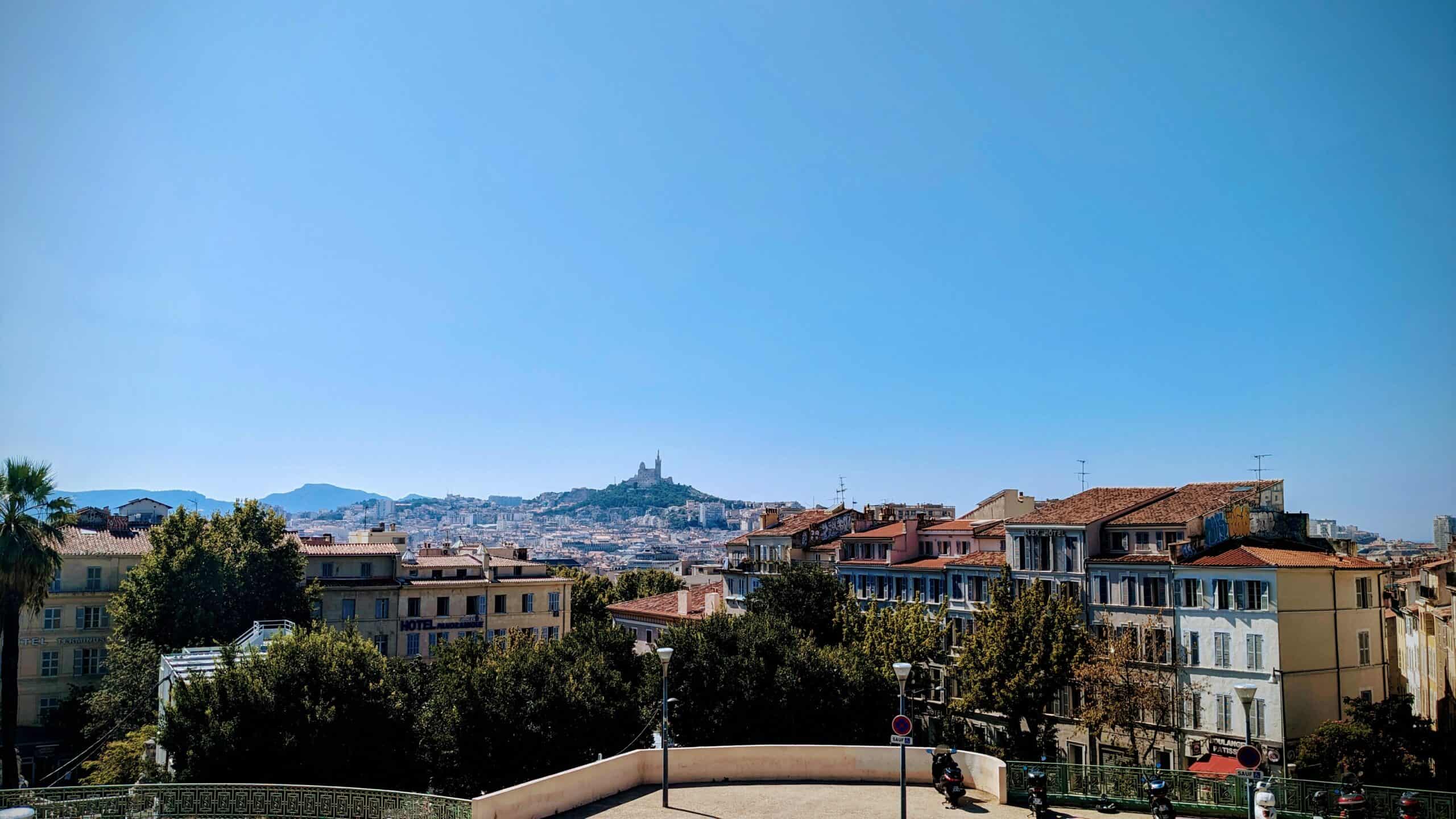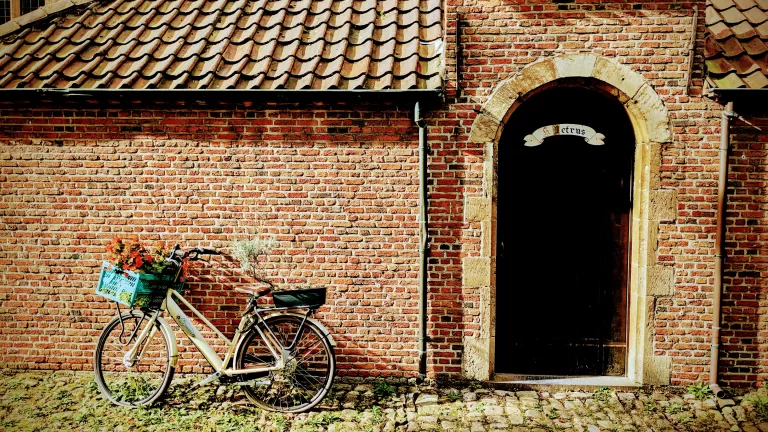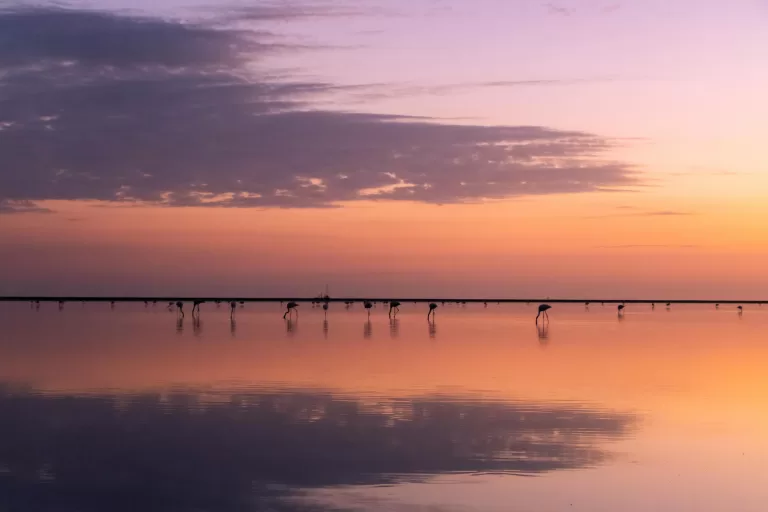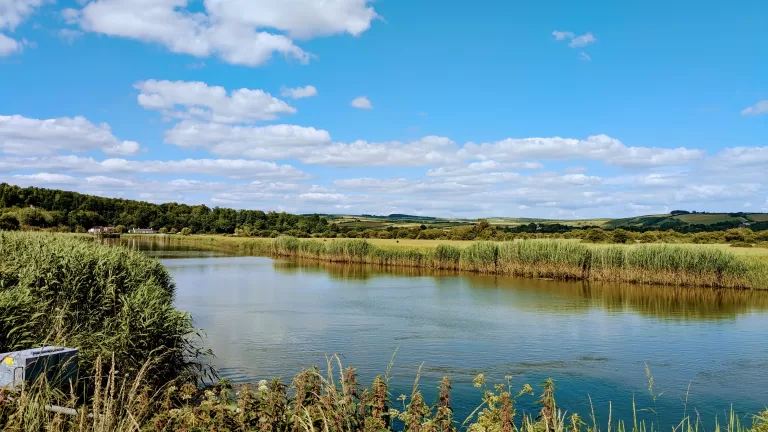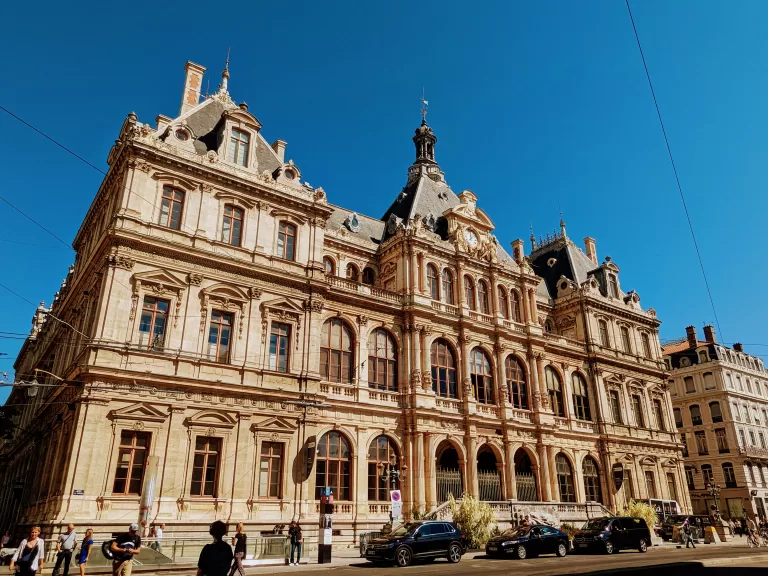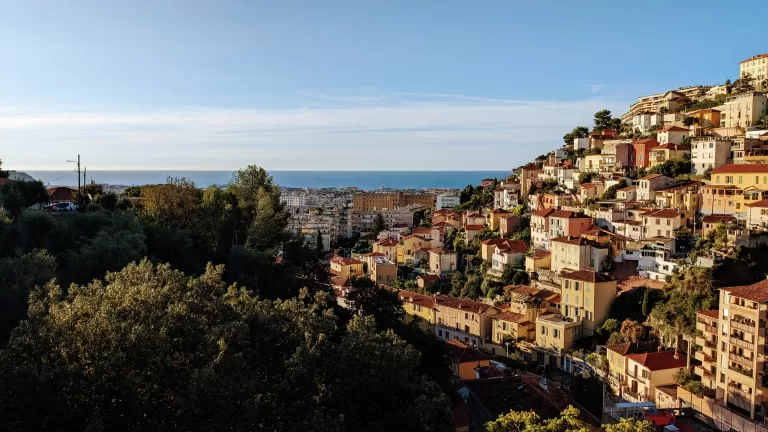Eurostar from London to Marseille: our step-by-step travel guide and tips
If you’re looking for a stress-free, scenic, and more sustainable way to travel from London to Marseille, then the Eurostar is the way to go.
A flight might seem faster on paper, but once you factor in airport security, baggage claim, and getting from the airport into the city, the train can be just as efficient – and far more enjoyable.
A flight might look quicker (London to Marseille is a 2-hour flight). But, once you add travel to Gatwick/Heathrow, 2 hours at the airport, baggage claim, and transfers from Marseille Provence airport into the city (30 min+), the total travel time is similar – or even longer – than taking the Eurostar + TGV.
Taking the Eurostar to Marseille means gliding through the English countryside, switching in Paris, and then heading down to the Mediterranean on a high-speed TGV.
Here’s our guide on exactly how to do it:
Why Take the Eurostar to Marseille?
Flying is the default option for most people, but we love taking the Eurostar when we can:
Eco-Friendly Travel: Taking the Eurostar and TGV emits up to 97% less CO₂ than flying. From your front door to your hotel door, we estimate flying uses around 120kg of CO₂ per person compared to 22kg if taking the Eurostar.
City-Centre to City-Centre: No costly airport transfers to and from the airport – arrive straight into the heart of the city at Marseille Saint-Charles station, just a 10-minute walk from the Old Port.
Comfort & Space: No crammed airline seats! You can stretch out, walk around, and enjoy the scenery.
No Luggage Fees: Unlike budget airlines, you can bring two suitcases and a small bag for free. If you wait for a sale, ticket prices can be cheaper than flying.
Save time: once you’ve factored in travelling to the airport, walking through it, waiting for your plane etc, getting the train doesn’t take that much longer.

Step 1: Booking your ticket from London to Paris (and onwards to Marseille)
Direct Eurostar services to Marseille were discontinued in 2020, so you’ll need to book a Eurostar to Paris.
There’s a short transfer in Paris, then a direct service TGV (high-speed train) from Paris to Marseille. You can buy a combined ticket through Eurostar (called Eurostar Sun, previously Thalys Sun) which links Eurostar and TGV services in a single booking. Check that it’s not cheaper to buy separate tickets.
Eurostar tickets go on sale six months in advance, with ticket prices starting around £39 one-way if you book early. It’s worth subscribing to the Eurostar newsletter and waiting for a sale – they happen quite regularly and have good availability for £39 fares. Book your train tickets direct on Eurostar for London to Paris.
For the TGV, we recommend buying your train tickets on SNCF Connect or Trainline. TGV tickets are best booked 3-4 months in advance for the best fares (as low as €25), and because they can get booked up in the summer months.
Choosing your ticket type
Eurostar trains have three travel classes:
Eurostar Standard: Standard class, free wifi, at-seat plug electrical sockets and light refreshments for purchase at the café. It’s like getting a normal train and perfectly comfortable.
Eurostar Plus: Lots of legroom and more space, a light meal included, quieter and nicer facilities such as extra comfy seats. In our opinion it’s the best way to travel, if the upgrade doesn’t cost much more (sometimes it’s as little as £15 more). It was previously known as Standard Premier.
Eurostar Premier: Access to Eurostar’s exclusive lounges, a fancy meal, and more flexible tickets including no extra charge to cancel or change your ticket. It’s a lot more expensive though, and we don’t think it’s worth the extra price. It was previously known as Business Premier.
Top tip: If you’re travelling with luggage, Eurostar Plus on Eurostar makes life easier with bigger seats and storage. There’s enough space to keep a small daypack with you at your seat.
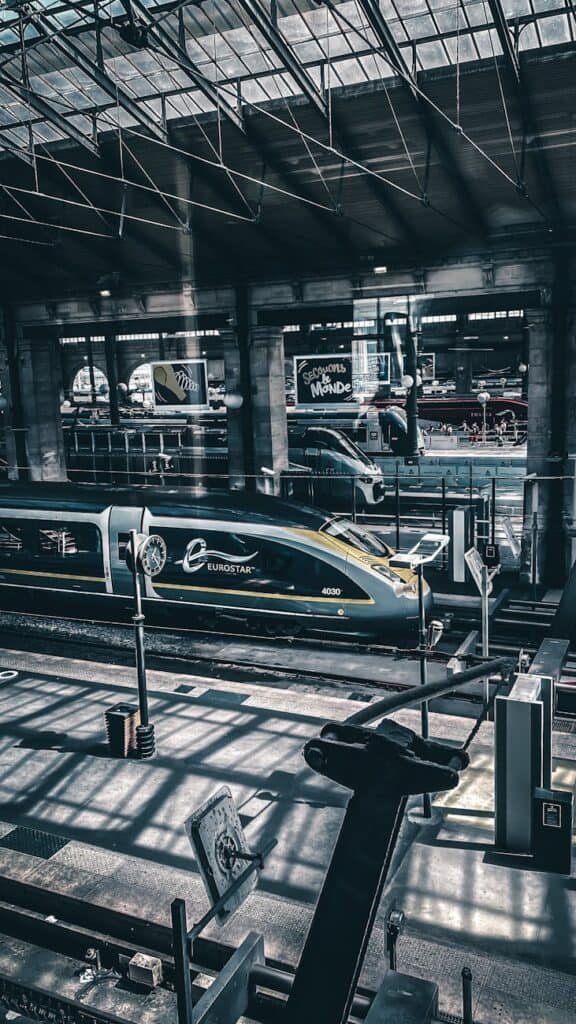
Step 2: Taking the Eurostar from St Pancras to Paris Gare du Nord
The first leg of the journey is from London St Pancras to Paris Gare du Nord, through the channel tunnel and into the centre of the French capital.
Journey time: 2 hours 15 minutes.
Check-in: Arrive at least 45-60 minutes before departure. Eurostar has airport-style security – it’s not as smooth as an airport, but shouldn’t take you long to get through. You’ll then go through passport checks – again, it’s not the smoothest so there might be a couple of minutes wait. One big benefit is that you’ll go through French passport control, so no waiting round for passport control when you exit the Eurostar in Paris.
Once you’re through the other side it’s a short walk to the departure lounge where there are a few cafes available. Be warned though, the departure lounge gets very busy and seating often runs out. There’s lots of decent cafes and bars in the station (before security) which might be better to wait in.
What to expect onboard: Comfortable seats, free Wi-Fi, and a Eurostar café bar serving snacks, drinks, and (of course) wine.
Step 3: Transferring from Paris Gare du Nord to Gare de Lyon (via RER or taxi)
Once you arrive in Paris, you’ll need to transfer from Paris Gare du Nord to Paris Gare de Lyon to catch your TGV to Marseille.
The fastest and most environmentally friendly way is the green RER D train (a suburban train, not the Metro).
Journey time: Just 9 minutes.
Ticket price: €2.50 (buy at the station or use a contactless card).
How? Follow signs for RER D, direction Melun or Malesherbes, and get off at Gare de Lyon (two stops).
You can also take a taxi. Expect to pay around €15-20, and it’ll take 30 minutes depending on traffic.
Tip: Allow at least 60-75 minutes to make train connections in case of delays. Paris is an exciting city and a destination on it’s own – so you could consider splitting your journey and having a few nights in Paris.
Step 4: getting the TGV train from Paris to Marseille
Once you’re at Gare de Lyon, it’s time for the TGV from Northern France to Marseille on the Mediterranean coast!
Journey time: 3 hours 15 minutes.
Speed: Up to 320 km/h (199 mph) – you’ll be flying past the French countryside, vineyards and lavender fields on a high speed train.
Onboard: Café bar, comfy seats, and free wifi (though it can be hit or miss).
If you’re lucky, you might get one of the newer TGV InOui trains, which are quieter, faster, and have better Wi-Fi.
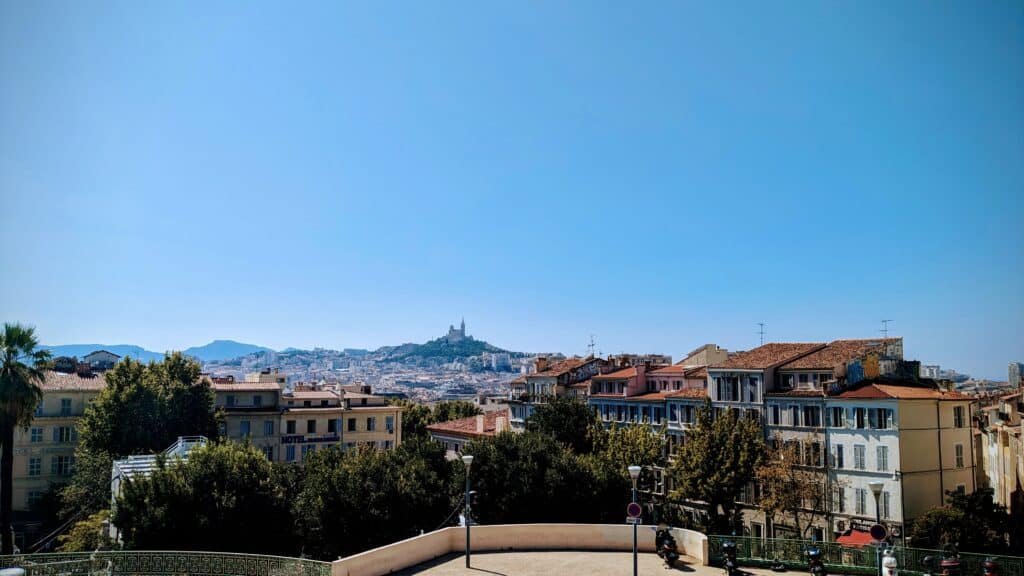
Step 5: Arriving in sunny Marseille
You’ll arrive at Marseille Saint-Charles, the city’s main train station, which is situated in the city’s 1st arrondissement. It’s right in the city centre, and next to the Old Port, so you have several options to get around:
Walking: If you’re staying near the Old Port, it’s just a 10-minute walk. Follow signs to the Vieux-Port – approximately 800m via Boulevard d’Athènes.
Metro: The station connects to Metro Lines 1 and 2, which can take you across the city.
Taxi: A taxi to the Vieux-Port costs around €10-15.
Tip: Before heading to your accommodation, take a moment to step out onto the station’s terrace – the view over the city is spectacular!
What about Lille?
Taking the Eurostar from London to Lille Europe (around 1 hour 30 minutes) and then catching a TGV from Lille to Marseille is another option.
Lille is a charming city to explore if you have a few hours to spare, and it could break up your journey nicely.
However, Lille connections often involve longer waits for TGVs to Marseille. Unless you want to explore Lille itself, Paris remains the faster and more reliable transfer point.
Our extra tips for a smooth journey
✔ Pack snacks – The food onboard is decent, but prices are high. Pick up a baguette and cheese in Paris before your TGV ride.
✔ Bring water – Eurostar has (rightly) phased out single use plastic.
✔ Download your tickets – SNCF sometimes has issues with foreign bank cards, so have PDF copies of your tickets just in case.
✔ Check for strikes – France loves a good train strike. Check SNCF’s website a few days before your trip.
✔ Try Citymapper – it’s great for public transport. It will automatically update when you’re in Paris, Lille or Marseille, and will help you make the transfer in Paris.
Frequently asked questions
Final thoughts: why the Eurostar to Marseille is worth it
Taking the train to Marseille isn’t just about convenience – it’s an experience in itself. You get to watch the landscape change, avoid the stress of airports, and travel in a way that’s far more sustainable than flying.
It’s all part of slow travel – this blog post talks more about it and why we love it.
Plus, when you finally step off the train, you’re already in the heart of one of France’s most vibrant cities, ready to explore its buzzing markets, turquoise waters, and mouth-watering seafood.
So, if you’re thinking of heading to the South of France, why not make the journey part of the adventure?
How did your trip go? Any tips we’ve missed? Drop them in the comments!
This page contains affiliate links. If you make a purchase through one of these links we make a small commission to help run this site, at no cost to you. Making a commission never affects the advice we give - see our content policy.

